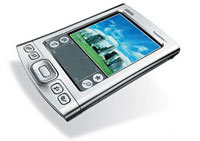 PalmOne’s Tungsten E – introduced in 2004 – proved to be a rip-roaring success, becoming the top-selling handheld in North America and among one of the best sellers world-wide.
PalmOne’s Tungsten E – introduced in 2004 – proved to be a rip-roaring success, becoming the top-selling handheld in North America and among one of the best sellers world-wide.
However, the handheld market has changed rapidly in the past eighteen months, with the growth of rival Windows powered PDAs and, more importantly, the explosion of smartphones offering PDA-like features.
Unlike the groundbreaking PDAs created by the innovative Sony Clie range (sadly since departed the Palm platform), palmOne have decided to play very safe indeed, with the new Tungsten E2 using the same tried’n’trusted design as the Tungsten E and Tungsten T5 units.
This means that the plastic tablet-style unit measures up at a reasonably lithe 114 x 78 x 15 mm and weighs a pocket-unchallenging 133 grams.
A square 320 x 320 16-bit colour TFT dominates the front of the unit, which palmOne claims is “typically 30% brighter than the Tungsten E display” with “40% better colour saturation”. As usual, there’s a fixed handwriting area below.
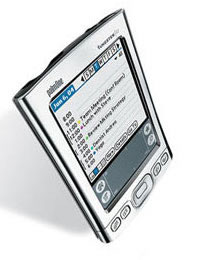 Apart from the inclusion of palmOne’s new Multi-Connector serial port (replacing the previous mini-USB port), everything is much the same as its predecessor, with the directional pad, application buttons, SDIO slot, IR port, headphone jack and metal barrel stylus being unchanged.
Apart from the inclusion of palmOne’s new Multi-Connector serial port (replacing the previous mini-USB port), everything is much the same as its predecessor, with the directional pad, application buttons, SDIO slot, IR port, headphone jack and metal barrel stylus being unchanged.
What is new, however, is the overdue inclusion of Bluetooth 1.1, supporting all the standard profiles with a helpful onscreen wizard aiding connectivity. Sadly, Wi-Fi is not included, although palmOne claims that the E2 works just dandy with their SDIO Wi-Fi card.
There’s been some tinkering under the hood, with the unit sporting a new 200 MHz processor (up from 126MHz) which should make most Palm apps purr along nicely, and the inclusion of non-volatile memory to avoid data loss in case the battery runs down. Shame there’s only a measly 32MB on offer though.
Battery life, as ever, is excellent, with some users reporting that they’ve managed to squeeze an amazing 17 hours of non-stop MP3 playback out of the device (palmOne claim a more modest 10-12 hours of continuous use).
MP3 playback comes courtesy of the bundled RealOne audio player, with users able to listen via the built in speaker or headphones.
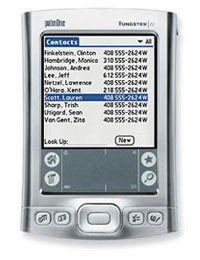 Other software includes a media suite (for playing back videos or viewing photo stills) an upgraded PIM suite, Web browser in ROM, with VersaMail and Documents To Go available on the included CD.
Other software includes a media suite (for playing back videos or viewing photo stills) an upgraded PIM suite, Web browser in ROM, with VersaMail and Documents To Go available on the included CD.
For an entry level PDA, the new palmOne E2 is a very capable device, with the inclusion of Bluetooth, superb battery life and improved multimedia features making it an attractive offering for budget-minded professionals and consumers looking for an affordable handheld.
OUR RATING: 4/5 stars Cost: £169 (US$249, €248)
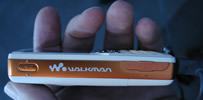 I had a Sony W800 Walkman Phone in my hands for the first time today at the Sony Media Experience in Bordeaux. There’s already been a terrific buzz about this camera and it was great to get my hands on the thing during what Sony claims was its first European outing.
I had a Sony W800 Walkman Phone in my hands for the first time today at the Sony Media Experience in Bordeaux. There’s already been a terrific buzz about this camera and it was great to get my hands on the thing during what Sony claims was its first European outing.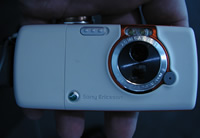 The central music button is the focus of the handset and, not surprisingly, pressing it takes you straight to your music selection.
The central music button is the focus of the handset and, not surprisingly, pressing it takes you straight to your music selection.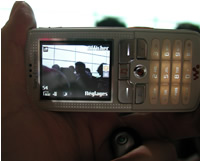 The software comes with the handset will take music CDs straight from the player on your machine to handset, without intervention.
The software comes with the handset will take music CDs straight from the player on your machine to handset, without intervention.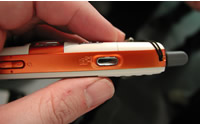
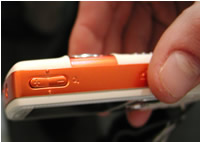
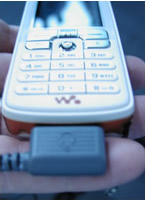
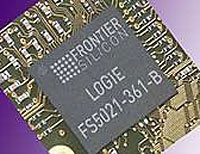 The whole caboodle measures only 55mm x 37mm x 13mm and is designed to mount inside a 1DIN radio/CD player.
The whole caboodle measures only 55mm x 37mm x 13mm and is designed to mount inside a 1DIN radio/CD player.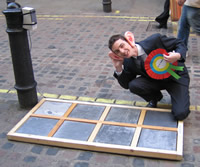 Living Streets, a national charity, launched its election campaign, “Talk to me about streets”, by making street items like paving and signs talk back to passers-by in Meard Street, Soho, London.
Living Streets, a national charity, launched its election campaign, “Talk to me about streets”, by making street items like paving and signs talk back to passers-by in Meard Street, Soho, London. Paving ‘squealed’ underfoot to point out the dangers of tripping over broken paving while spooky whispering windows resonated with the sound of absent children, no longer able to play in our dangerous streets.
Paving ‘squealed’ underfoot to point out the dangers of tripping over broken paving while spooky whispering windows resonated with the sound of absent children, no longer able to play in our dangerous streets.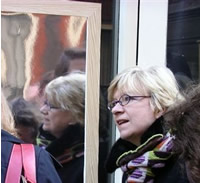 Living Streets Director Tom Franklin explains, “The streets are the one public service that everyone uses. Politicians can directly improve people’s daily lives by improving the street environment.”
Living Streets Director Tom Franklin explains, “The streets are the one public service that everyone uses. Politicians can directly improve people’s daily lives by improving the street environment.”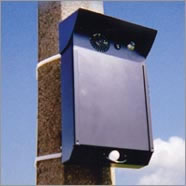 Verity Parker, who is doing an PhD at Brunel investigating electrical conductive fabrics, worked with Stock Displays to produce talking street signs, labelled in standard UK form, but with short audio samples.
Verity Parker, who is doing an PhD at Brunel investigating electrical conductive fabrics, worked with Stock Displays to produce talking street signs, labelled in standard UK form, but with short audio samples.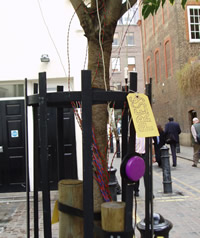 ‘The street that talks’ has the support of the Royal National Institute of the Blind, (RNIB) which also campaigns for streets and the built environment to be more accessible to blind and partially sighted people.
‘The street that talks’ has the support of the Royal National Institute of the Blind, (RNIB) which also campaigns for streets and the built environment to be more accessible to blind and partially sighted people. An accompanying new Living Streets’ pamphlet – written by two of Britain’s most eminent architects, Lord Richard Rogers and Sir Terry Farrell – was also unveiled at the event.
An accompanying new Living Streets’ pamphlet – written by two of Britain’s most eminent architects, Lord Richard Rogers and Sir Terry Farrell – was also unveiled at the event. Pace Micro Technology, a cutting edge UK digital set-top box provider tasked with developing emerging technologies across all television platforms, has trumpeted the launch of a number of STB’s and PVR’s, including the Laguna DC551HD and DC 501 Chicago all-digital set-top box.
Pace Micro Technology, a cutting edge UK digital set-top box provider tasked with developing emerging technologies across all television platforms, has trumpeted the launch of a number of STB’s and PVR’s, including the Laguna DC551HD and DC 501 Chicago all-digital set-top box. Pace is also offering the Tahoe DC775 HD-DVR, claiming it to be the most advanced high definition DVR for North America, and the first cable set-top box to offer features based on next generation silicon. Interestingly it offers a number of ways to save video content to the 160Gb hard drive – Standard Definition (SD), High Def (HD) and enhanced analogue. With multi-room video distribution and support for high-speed data connections for home computers, wireless routers and VoIP included you might be wondering what isn’t included.
Pace is also offering the Tahoe DC775 HD-DVR, claiming it to be the most advanced high definition DVR for North America, and the first cable set-top box to offer features based on next generation silicon. Interestingly it offers a number of ways to save video content to the 160Gb hard drive – Standard Definition (SD), High Def (HD) and enhanced analogue. With multi-room video distribution and support for high-speed data connections for home computers, wireless routers and VoIP included you might be wondering what isn’t included. Pace Americas’ VP of Technology Chris Dinallo had clearly feasted on a diet of buzzwords before adding, “All-digital and digital simulcast are critical industry initiatives, and uniquely, Pace is proud to be the only set-top box provider that can support all-digital on both networks.”
Pace Americas’ VP of Technology Chris Dinallo had clearly feasted on a diet of buzzwords before adding, “All-digital and digital simulcast are critical industry initiatives, and uniquely, Pace is proud to be the only set-top box provider that can support all-digital on both networks.” Samsung have jumped into bed with Digeo – a leading provider of media center software and services – and announced a deal to produce the next-generation Moxi II Media Center product family.
Samsung have jumped into bed with Digeo – a leading provider of media center software and services – and announced a deal to produce the next-generation Moxi II Media Center product family. US cable companies Charter Communications and Adelphia are set to be the first two cable companies to start dishing out the boxes to customers.
US cable companies Charter Communications and Adelphia are set to be the first two cable companies to start dishing out the boxes to customers. The cost-reducing chip will also offer improved graphics performance with Digeo cranking up the speed of the microprocessor from 733 megahertz to 1 gigahertz.
The cost-reducing chip will also offer improved graphics performance with Digeo cranking up the speed of the microprocessor from 733 megahertz to 1 gigahertz. Toshiba has developed a super-fast Lithium-Ion battery capable of being charged to 80 per cent of its full capacity in under 60 seconds. According to the company, a full charge takes just “a few more minutes”.
Toshiba has developed a super-fast Lithium-Ion battery capable of being charged to 80 per cent of its full capacity in under 60 seconds. According to the company, a full charge takes just “a few more minutes”. The 512Mb XDR (extreme data rate) DRAM chips run at a turbo-charged speed of 4.8GHz, which is about 12 times faster than that of the memory typically found in today’s desktop PCs.
The 512Mb XDR (extreme data rate) DRAM chips run at a turbo-charged speed of 4.8GHz, which is about 12 times faster than that of the memory typically found in today’s desktop PCs.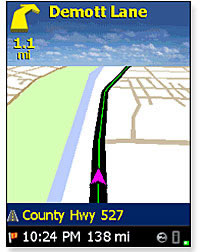 Motorola is to bundle GPS navigation software and hardware with the European versions of its A780 and MPx220 smart phones.
Motorola is to bundle GPS navigation software and hardware with the European versions of its A780 and MPx220 smart phones.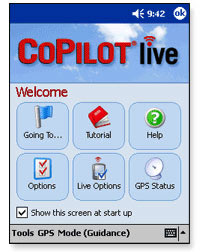 GPS navigation has proved a bit of a hit in Europe, with sales bolstering up an otherwise declining PDA market.
GPS navigation has proved a bit of a hit in Europe, with sales bolstering up an otherwise declining PDA market. Both handsets use Bluetooth to communicate with a separate GPS receiver.
Both handsets use Bluetooth to communicate with a separate GPS receiver. “The new IMAGEON processors from ATI combine advanced audio and video processing capabilities to turn mobile phones into mobile entertainment centers.”
“The new IMAGEON processors from ATI combine advanced audio and video processing capabilities to turn mobile phones into mobile entertainment centers.” Announced at the CeBIT tradeshow, Pretec have introduced a new memory card format for smartphones, called the C-Flash cards.
Announced at the CeBIT tradeshow, Pretec have introduced a new memory card format for smartphones, called the C-Flash cards.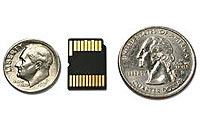 This format will also have support for MU-Card, a specification from China lead by Mu-Card Alliance. C-Flash has been adopted as the next small form factor version of MU-Card (called MU-Flash).
This format will also have support for MU-Card, a specification from China lead by Mu-Card Alliance. C-Flash has been adopted as the next small form factor version of MU-Card (called MU-Flash).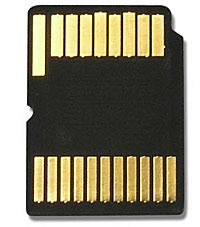 C-Flash has also been submitted to the MMC Association to be considered as the next small form factor standard of MMC.
C-Flash has also been submitted to the MMC Association to be considered as the next small form factor standard of MMC.